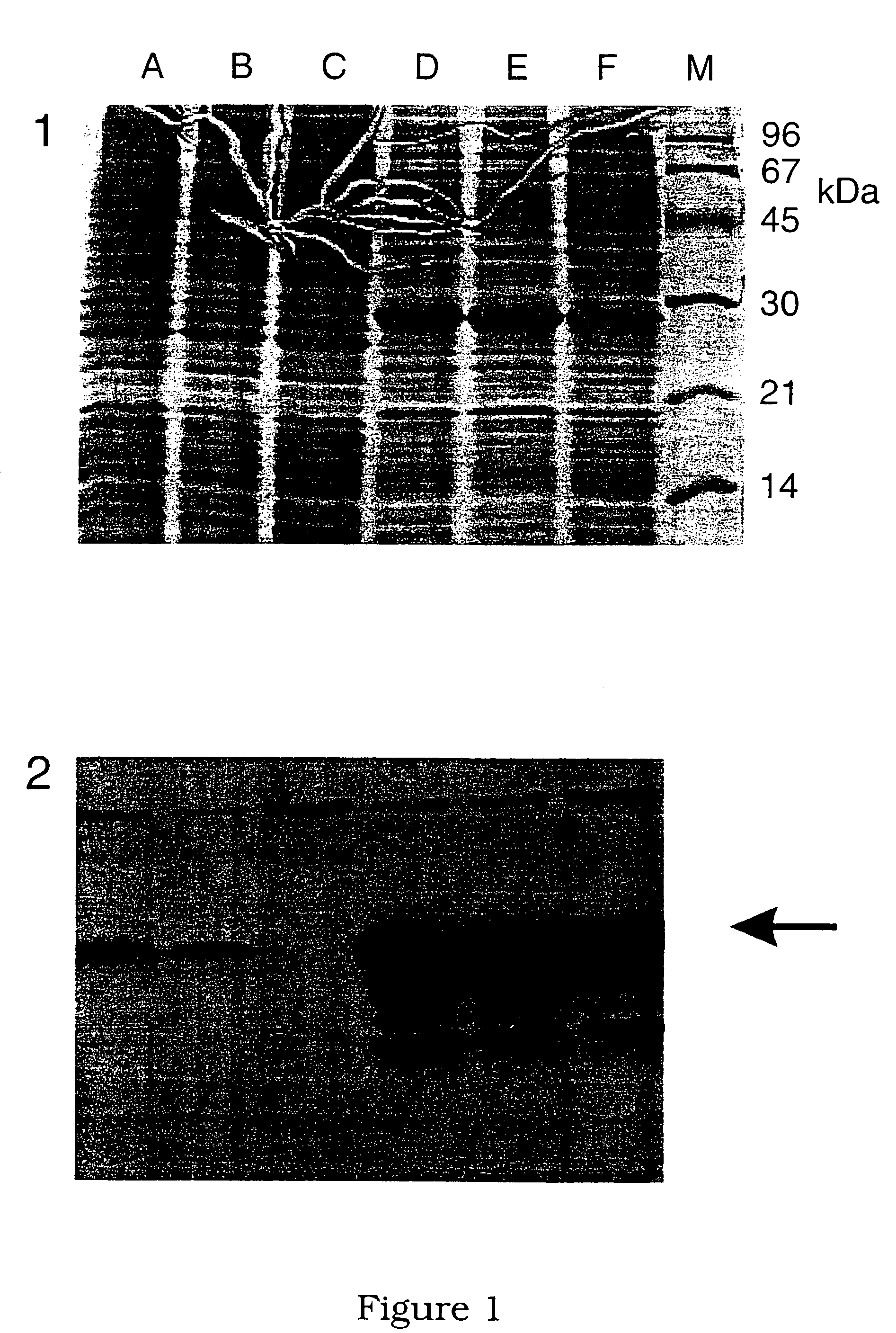Lawsonia derived gene and related OmpH polypeptides, peptides and proteins and their uses
a technology of omph polypeptides and derived genes, applied in the field of derived gene and related omph polypeptides, peptides and proteins, can solve the problems of reducing the growth rate of pigs, and increasing feed costs
- Summary
- Abstract
- Description
- Claims
- Application Information
AI Technical Summary
Benefits of technology
Problems solved by technology
Method used
Image
Examples
example 1
Sources of Pig Tissue
Infected Pig Intestines
[0219]Sections of grossly thickened ilea were taken from pigs naturally or experimentally affected by PPE. The presence of L. intracellularis bacteria in the ilea was confirmed using immunofluorescent staining with specific monoclonal antibodies (McOrist et al, 1987). An example of a suitable antibody is monoclonal antibody IG4 available from the University of Edinburgh, UK.
example 2
Isolation of Lawsonia Intracellularis Bacteria from the Infected Pig Ileum
[0220]Lawsonia intracellularis bacteria were extracted directly from lesions of PPE in pigs by filtration and further purified over a Percoll (Pharmacia, Uppsala, Sweden) gradient as follows. Infected ilea were collected from pigs and the presence of L. intracellularis was confirmed histologically before storage at −80° C. Sections of ileum were thawed and approximately 8 g of infected mucosa were scraped from the intestinal wall. The mucosa was homogenised with 40 ml sterile phosphate buffered saline (PBS) on half speed for 10 seconds using a Sorvall omnimixer. This suspension was centrifuged at 2000×g for 4 minutes. The supernatant was discarded and the cell pellet was resuspended in 40 ml PBS and re-centrifuged. This washing step was repeated twice. The cell pellet was then resuspended in 20 ml PBS and homogenised at full speed for one minute to release L. intracellularis bacteria.
[0221]This homogenate was ...
example 3
Purification of Lawsonia Intracellularis Genomic DNA
[0222]Genomic DNA was extracted from Percoll-gradient purified Lawsonia intracellularis bacteria recovered from infected pig ilea scrapings (Example 2) by the methods described by Anderson et al (1984) and Sambrook et al (1989).
[0223]Briefly, the L. intracellularis cells were pelleted by centrifugation at 14,000×g at 4° C. for 15 min. The cells were resuspended in 10 ml of TE buffer (1 mM Tris-HCl, 0.1 mM EDTA, pH 8.0) and centrifuged as before. The pellet was then resuspended in 4 ml of TE buffer containing 4 mg / ml lysozyme (Sigma Chemical Co.) and incubated at 37° C. for 20 min. SDS and proteinase K (Promega, Wis., USA) were added to final concentrations of 1% (w / v) and 200 μg / ml, respectively, and incubation was continued at 45° C. for 4 hours. The lysate was then extracted with an equal volume of phenol, phenol:chloroform (1:1) and chloroform, respectively, and the nucleic acids were recovered from the supernatant by ethanol pr...
PUM
| Property | Measurement | Unit |
|---|---|---|
| temperature | aaaaa | aaaaa |
| temperature | aaaaa | aaaaa |
| temperature | aaaaa | aaaaa |
Abstract
Description
Claims
Application Information
 Login to View More
Login to View More - R&D
- Intellectual Property
- Life Sciences
- Materials
- Tech Scout
- Unparalleled Data Quality
- Higher Quality Content
- 60% Fewer Hallucinations
Browse by: Latest US Patents, China's latest patents, Technical Efficacy Thesaurus, Application Domain, Technology Topic, Popular Technical Reports.
© 2025 PatSnap. All rights reserved.Legal|Privacy policy|Modern Slavery Act Transparency Statement|Sitemap|About US| Contact US: help@patsnap.com



